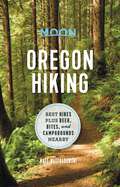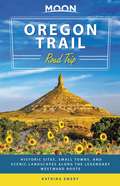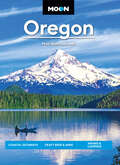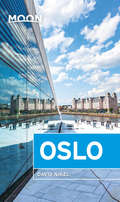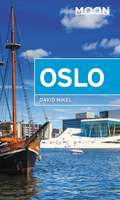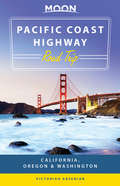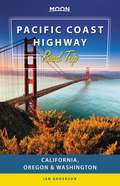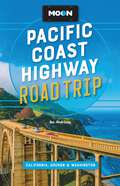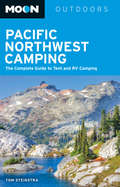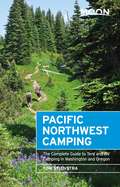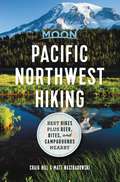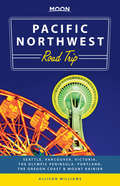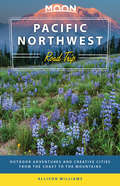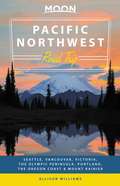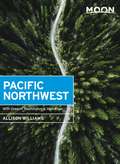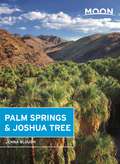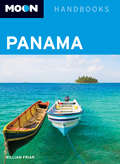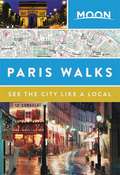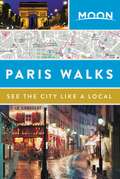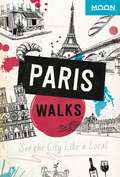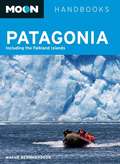- Table View
- List View
Moon Oregon Camping: The Complete Guide to Tent and RV Camping (Moon Outdoors)
by Tom StienstraMoon Travel Guides: Your Adventure Starts HereGrab your sleeping bag, pack the car, and discover the best spots to camp in the great outdoors with Moon Oregon Camping. Inside you'll find:A Campsite for Everyone: A variety of campgrounds and RV parks, from family-friendly car camping to secluded hike-ins, including dog-friendly and wheelchair accessible options Ratings and Essentials: All campsites are rated on a scenic scale and marked with amenities like restrooms, trailhead access, picnic areas, laundry, piped water, showers, and playgroundsRecreation Highlights: Discover nearby hiking, swimming, fishing, water-skiing, whitewater rafting, hot springs, and options for winter sportsMaps and Directions: Easy-to-use maps and detailed driving directions for each campgroundTrusted Advice: Expert outdoorsman Tom Stienstra is always on the move, having traveled more than a million miles across Oregon and the West over the past 25 yearsTips and Tools: Essentials like equipment, food and cooking, first aid, and insect protection, as well as background information on the climate, landscape, and history of the campsitesComprehensive Coverage: Moon Oregon Camping covers Portland and the Willamette Valley, the Southern Cascades, the Columbia River Gorge and Mount Hood, Northeastern and Southeastern Oregon, and the Oregon CoastWhether you're a veteran or a first-time camper, Moon's comprehensive coverage and trusted advice will have you gearing up for your next adventure.Sticking to the RV? Try Moon West Coast RV Camping. Can't get enough of the Pacific Northwest? Try Moon Washington Camping or Moon Olympic Peninsula.
Moon Oregon Fishing: The Complete Guide to Fishing Lakes, Rivers, Streams, and the Ocean
by Craig SchuhmannPack up your rod and reel, stock your tackle box, and head out to fish the best lakes, rivers, and saltwater areas in the Beaver State. Whether you're a first-time enthusiast or a seasoned veteran, you'll find the perfect destination with a range of options selected by expert angler Craig Schuhmann. From the waters of the Columbia River Gorge to the lakes of the Cascades, this is your guide to fishing in Oregon.
Moon Oregon Hiking: Best Hikes plus Beer, Bites, and Campgrounds Nearby
by Matt WastradowskiMisty ancient forests, rugged high deserts, and black sand beaches: wherever you turn in Oregon, adventure awaits. Pack a lunch, lace up your boots, and hit the trails with Moon Oregon Hiking. Inside you'll find:Diverse Hiking Options: Whether you plan to take peaceful walks along the coast or challenging treks up Mount Hood, enjoy outdoor getaways ranging from easy day hikes to multi-day backpacking tripsFind Your Hike: Looking for something specific? Choose from strategic lists of the best hikes for wildflowers, waterfalls, or hiking with your dog, plus a breakdown of the best hikes by seasonThe Top Outdoor Experiences: Explore a Mars-like red rock landscape in the Alvord Desert, or marvel at one of the 90 rushing waterfalls in the Colombia River Gorge. Peer into the mouth of a volcano crater, gaze at the Portland skyline from afar, or climb to the top of a picturesque lighthouse. Take a dip in relaxing hot springs, study real wagon ruts on the historic Oregon Trail, and spot puffins, pelicans, and plovers along the coastNearby Fun: Spend a night under the stars at a nearby campground, sip a refreshing local brew after a day of hiking, or enjoy fresh-caught fish at a beachfront restaurant Essential Planning Details: Each hike is described in detail and marked with round-trip distance and hiking time, difficulty, terrain type, elevation gain, and access pointsMaps and Directions: Find easy-to-use maps, driving directions to each trailhead, and details on where to parkExpert Advice: Seasoned hiker Matt Wastradowski offers experienced insights, local secrets, and honest opinions of each trailTips and Tools: Advice on gear, first aid, and camping permits, plus background information on climate, landscape, and wildlifeWhether you're a veteran or a first-time hiker, Moon's comprehensive coverage and local expertise will have you gearing up for your next adventure.Hitting the road? Check out Moon Pacific Northwest Road Trip!
Moon Oregon Trail Road Trip: Historic Sites, Small Towns, and Scenic Landscapes Along the Legendary Westward Route (Travel Guide)
by Moon Travel Guides Katrina EmeryVast rugged prairies, adventurous Wild West towns, and the palpable spirit of the pioneers: Experience legend come to life with Moon Oregon Trail Road Trip. Choose Your Route: Drive the entire 20-day road trip from Independence, Missouri, to Oregon City (at a mild, moderate, or strenuous pace!) or take shorter getaways along sections of the trail in Kansas, Nebraska, Wyoming, and Idaho, including worthwhile detoursDrive Through History: See the Guernsey Ruts left from wagons almost 200 years ago, read pioneer names carved into Register Rock, and learn about 10,000 years of oral Umatilla history. Practice loading a real wagon, down a mug of sarsaparilla in a recreated Old West town, and take a relaxing soak in the same hot springs as the pioneers Discover Diverse Historic Perspectives: Delve into the rich cultures and histories of the Native American tribes who have called these lands home for over 10,000 years. Venture through an underground city created and inhabited by Chinese pioneers. Learn the stories, struggles, and triumphs of free and enslaved black emigrants on the trail. Discover what life was really like for women making the journey westAdventure Along the Trail: Tube through the whitewater of Platte River, explore limestone caves, and kayak across clear blue lakesMaps and Driving Tools: Easy-to-use maps and full-color photos throughout keep you oriented on and off the highway as you follow the approximate route of the original Oregon Trail, along with site-to-site mileage, driving times, and detailed directionsExpert Insight: Oregon local and history buff Katrina Emery shares thorough background on the realities of the trail and recommendations for seniors, families with kids, and moreWith Moon Oregon Trail Road Trip's flexible itineraries and practical tips, you're ready to take an adventure through history. Looking to explore more of American history? Try Moon Route 66 Road Trip.
Moon Oregon: Coastal Getaways, Craft Beer & Wine, Hiking & Camping (Travel Guide)
by Matt WastradowskiStunning coastline, quirky towns, and a breathtaking array of natural wonders: Experience the best of the Beaver State with Moon Oregon. Inside you'll find:Flexible itineraries, whether you're visiting the Oregon Coast, checking out the Columbia River Gorge and Mount Hood, or road-tripping the whole state Strategic advice for outdoors-lovers, foodies, culture and history buffs, and more Can't-miss experiences and unique activities: Sample clam chowder in quaint seaside towns on a coastal road trip or get to know Portland's renowned craft beer scene. Catch a performance at the Shakespeare Festival in Ashland, shop for organic produce at a local farmers market, or sip your way through Oregon's best wineries Outdoor adventures: Hike to rushing waterfalls, soak in hidden hot springs, and spot wild mustangs, gray whales, or eagles. Trek to unbeatable views of Crater Lake (the deepest lake in America!), cycle along the Willamette River, or ski the fresh powder on Mount Hood Expert insight from Oregon local Matt Wastradowski on when to go, how to get around, and where to stay Full-color photos and detailed maps throughoutThorough background information on the culture, landscape, climate, and wildlife, plus handy recommendations for international visitors, families with kids, travelers of color, women travelers, and more Focused coverage of Portland, Columbia River Gorge and Mount Hood, the Willamette Valley, the Oregon Coast, Crater Lake and Southern Oregon, Bend and Central Oregon, and Eastern Oregon With Moon's expert tips and local know-how, you can experience the best of Oregon. Sticking to one spot? Try Moon Coastal Oregon or Moon Columbia River Gorge & Mount Hood. Looking for outdoor adventure? Check out Moon Oregon Hiking. About Moon Travel Guides: Moon was founded in 1973 to empower independent, active, and conscious travel. We prioritize local businesses, outdoor recreation, and traveling strategically and sustainably. Moon Travel Guides are written by local, expert authors with great stories to tell—and they can't wait to share their favorite places with you. For more inspiration, follow @moonguides on social media.
Moon Oslo (Travel Guide)
by David NikelMoon Travel Guides: Your World Your WayOne of Europe's fastest growing cities, Oslo offers visitors a perfect mixture of art, culture, and wilderness. Discover Norway's vibrant capital with Moon Oslo.Strategic itineraries for any budget or timeline, from three days in the city to island-hopping in the Oslofjord, plus day trips to Frederikstad and LillehammerUnique attractions and can't-miss activities: Visit the waterfront opera house, National Gallery, or Royal Palace for a taste of art and culture, or tour the Viking Ship Museum to explore Norway's ancient past. Wander the Akerselva Riverwalk, sample some of Oslo's delicious traditional foods, or splurge on seasonal Scandinavian delights at one of the city's four Michelin-starred restaurants. Go island-hopping by sailboat, explore skerries, lighthouses, and quaint fjordside towns, or take the metro to the cross-country ski trails surrounding the cityExpert advice from expat-turned-local David Nikel on when to go, where to stay, and how to get aroundFull-color, vibrant photos and detailed maps for exploring on your ownThorough background information on the landscape, history, and cultureHandy tools including a Norwegian phrasebook and tips for LGBTQ+ travel, visitors with disabilities, and business travelersFocused coverage of Downtown Oslo, Frogner & Bygødy, Grunerløkka, Frognerseteren, Nordmarka, Østmarka, and HovedøyaWith Moon Oslo's practical tips, myriad activities, and an insider's view on the best things to do and see, you can plan your trip your way.Exploring beyond the city? Try Moon Norway. For more Nordic adventures, check out Moon Iceland or Moon Reykavíc.
Moon Oslo (Travel Guide)
by David NikelOne of Europe's fastest growing cities, Oslo is brimming with art, culture, and outdoor adventure. Discover the best of Norway's colorful capital with Moon Oslo. Inside you'll find:A range of flexible itineraries, from three days in the city to island-hopping in the Oslofjord, plus day trips to Frederikstad and LillehammerStrategic advice designed for history buffs, nightlife-seekers, foodies, and moreUnique experiences and can't-miss sights: Visit the waterfront opera house, National Gallery, or Royal Palace for a taste of Norwegian culture, or tour the Viking Ship Museum to explore the country's ancient past. Wander the Akerselva Riverwalk, sample some of Oslo's delicious traditional foods, or splurge on seasonal Scandinavian delights at one of the city's four Michelin-starred restaurants. Go island-hopping by sailboat, explore skerries, lighthouses, and quaint fjordside towns, or take the metro to the cross-country ski trails surrounding the cityExpert advice from expat-turned-local David Nikel on when to go, where to stay, and how to get aroundFull-color photos and detailed maps for exploring on your ownThorough background information on the landscape, history, and cultureHandy tools including a Norwegian phrasebook and tips for visitors with disabilities, business travelers, and moreWith Moon Oslo's practical tips and local insight on the best things to do and see, you can plan your trip your way.Exploring beyond the city? Try Moon Norway. For more Nordic adventures, check out Moon Iceland or Moon Reykjavík.
Moon Pacific Coast Highway Road Trip
by Victoriah ArsenianThis full-color guidebook includes easy-to-use maps to keep you oriented on and off the highway. Hit the road! California, Oregon, and Washington: explore the top destinations along the West Coast with this book as your guide. Our detailed driving routes give you all you need, including mileage from place to place, driving times, and advice on the best places to stop along the way to eat, sleep, and explore. Get the most out of your trip with the definitive Two-Week Pacific Coast Highway Road Trip, along with suggestions for spending two days in Seattle, Portland, San Francisco, Los Angeles, and San Diego, and tips for finding the "Best Views" and "Best Beaches" along this gorgeous coastline.
Moon Pacific Coast Highway Road Trip: California, Oregon & Washington (Travel Guide)
by Ian AndersonHit the Road with Moon Travel Guides!1,700 miles of vibrant cities, coastal towns, and glittering ocean views: Embark on your epic PCH journey with Moon Pacific Coast Highway Road Trip. Inside you'll find:Maps and Driving Tools: 48 easy-to-use maps keep you oriented on and off the highway, along with site-to-site mileage, driving times, detailed directions for the entire route, and full-color photos throughoutEat, Sleep, Stop and Explore: Coast by fields of golden California poppies or stop at a seaside grill in Santa Barbara for the best chicharrón and fish tacos you've ever tasted. Marvel at the mystical evergreen giants of the Pacific Northwest, or dance down rainbow-colored streets in San Francisco's Castro district. You'll know exactly what you'll want to do at each stop with lists of the best hikes, views, restaurants, and moreItineraries for Every Traveler: Drive the entire two-week route or follow suggestions for spending time in Seattle, Portland, San Francisco, Los Angeles, and San DiegoLocal Expertise: Born-and-bred Californian Ian Anderson shares his love of the open road with youPlanning Your Trip: Know when and where to get gas, how to avoid traffic, tips for driving in different road and weather conditions, and suggestions for LGBTQ travelers, seniors, and road trippers with kidsWith Moon Pacific Coast Highway Road Trip's practical tips, detailed itineraries, and insider's view, you're ready to fill up the tank and hit the road.Looking to explore more of America on wheels? Try Moon California Road Trip or Moon Pacific Northwest Road Trip! Doing more than driving through? Check out Moon California, Moon Oregon, or Moon Washington.
Moon Pacific Coast Highway Road Trip: California, Oregon & Washington (Travel Guide)
by Ian Anderson1,700 miles of vibrant cities, coastal towns, and glittering ocean views: Embark on your epic PCH journey with Moon Pacific Coast Highway Road Trip. Inside you'll find:Flexible Itineraries: Drive the entire three-week route or follow suggestions for shorter getaways to Seattle, Portland, San Francisco, Los Angeles, and San DiegoEat, Sleep, Stop and Explore: With lists of the best beaches, views, restaurants, and more, you'll cruise by sky-scraping redwoods, misty green rain forests, and the black sands of the Lost Coast. Slurp fresh-caught oysters, order up Julia Child's favorite street tacos, or kick back with a craft beer. Dance down rainbow-colored streets in San Francisco's Castro District, tour Seattle's underground old city, and see the stars on the Hollywood Walk of Fame Maps and Driving Tools: 48 easy-to-use maps keep you oriented on and off the highway, along with site-to-site mileage, driving times, detailed directions for the entire route, and full-color photos throughoutLocal Expertise: Californian Ian Anderson shares his love of the open roadPlanning Your Trip: Know when and where to get gas, how to avoid traffic, tips for driving in different road and weather conditions, and suggestions for seniors, travelers with disabilities, and road trippers with kidsWith Moon Pacific Coast Highway Road Trip's practical tips and detailed itineraries, you're ready to and hit the road.Doing more than driving through? Check out Moon Seattle, Moon Portland, Moon San Diego, or Moon Los Angeles.
Moon Pacific Coast Highway Road Trip: California, Oregon & Washington (Travel Guide)
by Ian Anderson1,700 miles of vibrant cities, coastal towns, and glittering ocean views: Embark on your epic PCH journey with Moon Pacific Coast Highway Road Trip. Inside you'll find:Flexible Itineraries: Drive the entire three-week route or follow suggestions for shorter getaways to Seattle, Portland, San Francisco, Los Angeles, and San Diego Eat, Sleep, Stop and Explore: With lists of the best beaches, views, restaurants, and more, you'll cruise by sky-scraping redwoods, misty green rainforests, and the black sands of the Lost Coast. Slurp fresh-caught oysters, order up authentic street tacos, or kick back with a craft beer. Dance down rainbow-colored streets in San Francisco's Castro District, tour Seattle's underground old city, and see the stars on the Hollywood Walk of Fame Maps and Driving Tools: 48 easy-to-use maps keep you oriented on and off the highway, along with site-to-site mileage, driving times, detailed directions for the entire route, and full-color photos throughout Local Expertise: Californian Ian Anderson shares his love of the open road Planning Your Trip: Know when and where to get gas, how to avoid traffic, tips for driving in different road and weather conditions, and suggestions for seniors, travelers with disabilities, and road trippers with kids With Moon Pacific Coast Highway Road Trip's practical tips and detailed itineraries, you're ready to hit the road. Looking for more scenic road trips in America? Try The Open Road.About Moon Travel Guides: Moon was founded in 1973 to empower independent, active, and conscious travel. We prioritize local businesses, outdoor recreation, and traveling strategically and sustainably. Moon Travel Guides are written by local, expert authors with great stories to tell—and they can't wait to share their favorite places with you. For more inspiration, follow @moonguides on social media.
Moon Pacific Northwest Camping
by Tom StienstraTop-selling outdoors writer Tom Stienstra covers the adventures of camping in the Pacific Northwest, including notable campsites along the Olympic Peninsula and Washington Coast, as well as the Southern Cascades, Mount Rainier, and the Columbia River Gorge. Stienstra provides easy-to-follow maps with driving directions to each campground, along with camping options from secluded alpine hike-ins to convenient roadside stop-overs. Complete with details on what to pack, what to wear, reservations, fees, and the best camping facilities, Moon Pacific Northwest Camping gives travelers the tools they need to create a more personal and memorable camping experience.
Moon Pacific Northwest Camping: The Complete Guide to Tent and RV Camping in Washington and Oregon (Moon Outdoors)
by Tom StienstraPristine mountain lakes, dramatic coastlines, and unforgettable national forests: Moon Pacific Northwest Camping has a spot for you. Inside you'll find:A Campsite for Everyone: A variety of campgrounds and RV parks, from family-friendly car camping to secluded hike-ins, plus dog-friendly and wheelchair-accessible optionsRatings and Essentials: Campsites are rated on a helpful scenic scale and marked with amenities like restrooms, trailhead access, picnic areas, laundry, piped water, showers, and playgroundsRecreation Highlights: Discover nearby hiking, swimming, fishing, water-skiing, whitewater rafting, hot springs, and options for winter sportsMaps and Directions: Easy-to-use maps and detailed driving directions for each campgroundTrusted Advice: Expert outdoorsman Tom Stienstra is always on the move, having traveled thousands of miles across Washington and Oregon over the past 25 yearsTips and Tools: Information on equipment, food and cooking, first aid, and insect protection, as well as background information on the climate, landscape, and history of the campsitesIn-Depth Coverage: Moon Pacific Northwest Camping covers Oregon and Washington, including: the Olympic Peninsula and the Washington Coast, Seattle and Puget Sound, the Northern and Southern Cascades, Northeastern Washington, the Columbia River Gorge and Mount Rainier, Southeastern Washington, the Oregon Coast, Portland and the Willamette Valley, Mount Hood, and Northeastern and Southeastern OregonWhether you're a veteran camper or pitching a tent for the first time, with Moon's comprehensive coverage and strategic advice you'll be ready for your next adventure.Sticking to the RV? Try Moon West Coast RV Camping. Can't get enough of the Northwest? Try Moon Washington Camping or Moon Oregon Camping.
Moon Pacific Northwest Hiking: Best Hikes Plus Beer, Bites, and Campgrounds Nearby (Moon Hiking Travel Guide)
by Craig Hill Moon Travel Guides Matt WastradowskiTowering peaks, sparkling coastline, and vast old-growth forests: wherever you turn in the Pacific Northwest, adventure awaits. Pack a lunch, lace up your boots, and hit the trails with Moon Pacific Northwest Hiking. Inside you'll find:Diverse Hiking Options: Whether you plan to take breathtaking coastal walks in Oregon or challenging treks around Mount Rainier, enjoy outdoor getaways ranging from easy day hikes to multi-day backpacking trips Find Your Hike: Looking for something specific? Choose from strategic lists of the best hikes for waterfalls, wildflowers, four-legged friends, and more, plus a breakdown of the best hikes by season The Top Outdoor Experiences: Wander through the damp, dense greens of a rainforest in Olympic National Park or revel in a Mars-like red rock landscape in southeastern Oregon. Watch a stunning sunset on a beach scattered with sea stacks or gaze into the mouth of a volcano crater. Catch a glimpse of a bighorn sheep, see actual wagon ruts on the historic Oregon Trail, and stroll through fields of wildflowers. Walk behind a waterfall or take in sweeping views of the downtown Portland skyline Nearby Fun: Kick back at a local brewery after a day on the trail, spend a night under the stars at a nearby campground, or enjoy a plate of fresh oysters with an ocean view Essential Planning Details: Each hike is described in detail and marked with round-trip distance and hiking time, difficulty, terrain type, elevation gain, and access points Maps and Directions: Find easy-to-use maps, driving directions to each trailhead, and details on where to park Expert Advice: Seasoned hikers Craig Hill and Matt Wastradowski offer experienced insights, local secrets, and honest opinions of each trail Tips and Tools: Advice on gear, first aid, and camping permits, plus background information on climate, landscape, and wildlife Moon Pacific Northwest Hiking covers hikes in Washington and Oregon Whether you're a veteran or a first-time hiker, Moon's comprehensive coverage and local expertise will have you gearing up for your next adventure. Hitting the road? Check out Moon Pacific Northwest Road Trip!About Moon Travel Guides: Moon was founded in 1973 to empower independent, active, and conscious travel. We prioritize local businesses, outdoor recreation, and traveling strategically and sustainably. Moon Travel Guides are written by local, expert authors with great stories to tell—and they can't wait to share their favorite places with you. For more inspiration, follow @moonguides on social media.
Moon Pacific Northwest Hiking: Best Hikes plus Beer, Bites, and Campgrounds Nearby (Moon Outdoors Ser.)
by Craig Hill Matt WastradowskiTowering peaks, sparkling coastline, and vast old-growth forests: wherever you turn in the Pacific Northwest, adventure awaits. Pack a lunch, lace up your boots, and hit the trails with Moon Pacific Northwest Hiking. Inside you'll find:Diverse Hiking Options: Whether you plan to take breathtaking coastal walks in Oregon or challenging treks around Mount Rainier, enjoy outdoor getaways ranging from easy day hikes to multi-day backpacking tripsFind Your Hike: Looking for something specific? Choose from strategic lists of the best hikes for waterfalls, wildflowers, bringing your dog, and more, plus a breakdown of the best hikes by seasonThe Top Outdoor Experiences: Wander through the damp, dense greens of a rainforest in Olympic National Park or revel in a Mars-like red rock landscape in southeastern Oregon. Watch an orange sunset on a beach adorned with sea stacks or gaze into the mouth of a volcano crater. Catch a glimpse of a bighorn sheep, see actual wagon ruts on the historic Oregon Trail, and stroll through fields of wildflowers. Walk behind a waterfall or take in unbridled views of the downtown Portland skyline Nearby Fun: Kick back at a local brewery after your hike, find a nearby campground for a night under the stars, or enjoy a plate fresh oysters with an ocean view Essential Planning Details: Each hike is described in detail and marked with round-trip distance and hiking time, difficulty, terrain type, elevation gain, and access pointsMaps and Directions: Find easy-to-use maps, driving directions to each trailhead, and details on where to parkExpert Advice: Seasoned hikers Craig Hill and Matt Wastradowski reveal their experienced insights, local secrets, and honest opinions of each trailTips and Tools: Advice on gear, first aid, and camping permits, plus background information on climate, landscape, and wildlifeMoon Pacific Northwest Hiking covers hikes in Washington and OregonWhether you're a veteran or a first-time hiker, Moon's comprehensive coverage and local expertise will have you gearing up for your next adventure.Hitting the road? Check out Moon Pacific Northwest Road Trip!
Moon Pacific Northwest Road Trip
by Allison WilliamsIn this full-color guide, Seattle resident Allison Williams shares expert tips for road tripping through Oregon, Washington, and British Columbia. Offering shorter options like the Portland Loop and a route between Seattle and Vancouver, Moon Pacific Northwest Road Trip is perfect for all travelers.Detailed driving instructions tell you how far you'll have to drive, how long it will take, and which highways you'll need to follow-including information on alternate routes and the best places to stop along the way.Day-by-day itinerary suggestions tell you the best ways to spend your time:The 17-Day Northwest RouteThree Days in SeattleTwo Days in VancouverOne Day in VictoriaTwo Days on the Olympic PeninsulaOne Day on the Oregon CoastTwo Days in PortlandTwo Days in Central OregonTwo Days in Washington Wine CountryOne Day in Mount Rainier National ParkEasy-to-use maps keep you oriented along the way and prepare you for your trip through the Pacific Northwest.
Moon Pacific Northwest Road Trip: Outdoor Adventures and Creative Cities from the Coast to the Mountains (Travel Guide)
by Allison WilliamsBuckle up for the best of the PNW's breathtaking wilderness, eclectic cities, and quaint coastal towns with Moon Pacific Northwest Road Trip. Inside you'll find:Multiple Routes: Take the full two-week trip or mix and match suggestions for spending time in the Olympic Peninsula, Seattle, Portland, the Oregon Coast, Vancouver, and moreEat, Sleep, Stop and Explore: With lists of the best hikes, views, and more, you can venture through lush rainforest in search of towering waterfalls, race across sand dunes on the Oregon Coast, and kayak the Puget Sound. Marvel at totem poles carved by First Nation tribes in Vancouver, study the contemporary masterpieces at the Seattle Art Museum, or tour Oregon's collection of picturesque lighthouses. Indulge in a food truck feast in Portland, sample cheese and ice cream in Tillamook, or snack on authentic Canadian poutineMaps and Driving Tools: Over 30 easy-to-use maps keep you oriented on and off the highway, along with site-to-site mileage, driving times, detailed directions, and full-color photos throughoutLocal Insight: Native Washingtonian and outdoorswoman Allison Williams shares her favorite spots and experiences in the Pacific NorthwestPlanning Your Trip: Know when and where to get gas, how to avoid traffic, tips for driving in different road and weather conditions, and suggestions for LGBTQ+ travelers, seniors, and road trippers with childrenWith Moon Pacific Northwest Road Trip's flexible itineraries and practical tips for weekend getaways or a complete PNW escape, you're ready to fill up and hit the road! Looking to explore more of the West on wheels? Try Moon Pacific Coast Highway Road Trip! Doing more than driving through? Check out Moon Coastal Oregon or Moon Olympic Peninsula. About Moon Travel Guides: Moon was founded in 1973 to empower independent, active, and conscious travel. We prioritize local businesses, outdoor recreation, and traveling strategically and sustainably. Moon Travel Guides are written by local, expert authors with great stories to tell—and they can't wait to share their favorite places with you.For more inspiration, follow @moonguides on social media.
Moon Pacific Northwest Road Trip: Seattle, Vancouver, Victoria, the Olympic Peninsula, Portland, the Oregon Coast & Mount Rainier (Travel Guide)
by Allison WilliamsHit the Road with Moon Travel Guides!Discover vibrant cities like Seattle, Vancouver, and Portland, and explore the emerald wilderness in between with Moon Pacific Northwest Road Trip. Inside you'll find:Maps and Driving Tools: 31 easy-to-use maps keep you oriented on and off the highway, along with site-to-site mileage, driving times, detailed directions for the entire route, and full-color photos throughoutEat, Sleep, Stop and Explore: With lists of the best hikes, views, and more, you can climb Mount Rainier or relax in Seattle with a freshly brewed cup of coffee or a local craft beer. Hike the temperate rainforests of Oregon, kayak the Puget Sound in Washington, hit the ski slopes in Whistler, or take the ferry to Canada to see First Nations art Flexible Itineraries: Drive the entire two-week route or follow suggestions for spending time in Vancouver, Victoria, the Olympic Peninsula, Seattle, the Oregon Coast, Portland, Neah Bay, Port Angeles, Greenwater, Paradise, Olympia, Astoria, Aberdeen, or NewportLocal Insight: Native Washingtonian and outdoorswoman Allison Williams shares her love of the Pacific NorthwestPlanning Your Trip: Know when and where to get gas, how to avoid traffic, tips for driving in different road and weather conditions, and suggestions for LGBTQ travelers, seniors, and road trippers with kidsWith Moon Pacific Northwest Road Trip's practical tips, detailed itineraries, and local know-how, you're ready to fill up the tank and hit the road.Looking to explore more of America on wheels? Try Moon Pacific Coast Highway Road Trip! Doing more than driving through? Check out Moon Seattle or Moon Vancouver.
Moon Pacific Northwest: With Oregon, Washington & Vancouver (Travel Guide)
by Allison WilliamsRugged mountains, wild coastlines, and dense forests coexist with vibrant, diverse cities in one of the wildest corners of North America. Explore the PNW with Moon Pacific Northwest. Inside you'll find:Flexible, strategic itineraries ranging from two-day getaways to Seattle, Portland, and Vancouver to a two-week Pacific Northwest road trip The best spots for outdoor adventures, including hiking, biking, whitewater rafting, and skiing The top sights and unique experiences: Hike through rain forests and alpine meadows, trek jagged ridges in the Cascade Mountains, or drive along the wild Oregon coast. Learn about the First Nations culture in Vancouver, catch a performance at the Oregon Shakespeare Festival, or visit Pike Place Market in Seattle. Spot orcas in the San Juan Islands, or head up to Whistler to ski the powdery slopes. Taste world-class cabernets and merlots in wine country, stomp your own grapes during the harvest, and hop your way through local craft breweries. Grab a bite from Portland's famous food trucks, enjoy freshly caught salmon, or stroll along Vancouver's scenic waterfrontExpert advice from Seattle local Allison Williams on when to go, where to stay, and where to eat Full-color photos and detailed maps throughoutBackground information on the landscape, plants and animals, history, and cultureTravel tips for international visitors, seniors, families with children, and LGBTQ travelersFull coverage of Seattle, the Cascades, the Olympic Peninsula, the San Juan Islands, Washington Wine Country, Portland, the Willamette Valley, Bend and Central Oregon, the Oregon Coast, Ashland and Southern Oregon, Vancouver, Victoria, and Vancouver IslandWith Moon Pacific Northwest's expert tips and local know-how, you can plan your trip your way.Sticking to one region? Check out Moon Oregon, Moon Washington, or Moon Victoria & Vancouver Island.
Moon Palm Springs & Joshua Tree (Moon Handbooks Ser.)
by Jenna BloughJoin local writer and desert aficionado Jenna Blough for an unforgettable experience. With her unique perspective and advice you can trust, Moon Palm Springs & Joshua Tree has everything you need to know to have a more personal and memorable experience.Moon Palm Springs & Joshua Tree has something for every traveler. From the relaxing resort town of Palm Springs to the rugged and pristine desert of Joshua Tree National Park, Moon Palm Springs & Joshua Tree is your go-to guide for getting to most out of your trip. Climb the twisted rocks of Joshua Tree and camp out far from any light pollution for unparalleled stargazing opportunities, or explore the Old Hollywood style and modern amenities of Palm Springs, from spas and art galleries to world class music festivals.With 46 expertly crafted maps and gorgeous photos, this full-color guidebook gives you the tools you need to have an immersive and unique experience. Moon Palm Springs & Joshua Tree includes areas such as:Downtown Palm SpringsCoachella ValleyDesert Hot SpringsJoshua Tree National Park29 PalmsYucca ValleyFind the Moon guide that best suits your trip! Spending more time in the area? Check out Moon California. Looking for more outdoor adventure? Try Moon Death Valley National Park.
Moon Panama
by William FriarWriter and Panama native William Friar offers unique tips for visiting this up-and-coming destination, from lounging in the Caribbean islands of Bocas del Toro to hiking the highlands of Boquete and exploring Panama City. Friar uses his local knowledge to craft unique trip strategies, such as The 14-day Outdoor Adventure and Six Days for History Buffs. Complete with details for navigating jungle trails, finding cheap taxis and underground bars, and planning a river expedition, Moon Panama gives travelers the tools they need to create a more personal and memorable experience.
Moon Paris Walks
by Moon Travel GuidesExperience the City of Lights like a local: on foot! Stroll along cobblestone alleys and grand boulevards, discover chic restaurants and trendy shops, and bask in la vie Parisienne with Moon Paris Walks. This full-color guide features: Six customizable walks through the city's hippest neighborhoods, including Montmartre, le Marais, Saint Germain, and more, with color-coded stops and turn-by-turn directions; Foldout maps of each route and a removable full-city map, in a handy, portable guide; Curated "Top Ten" lists for restaurants, shopping, nightlife, and activities for a sleepy Sunday, for visitors looking to hit the highlights; The top attractions and the best-kept local secrets: Meander cobblestone alleyways to find a local corner café, and people-watch from the terrace over lunch. Wander through the Latin Quarter to Notre Dame, and stroll through the verdant public gardens. Visit world-famous museums and galleries like the Louvre, or shop for designer threads at the hippest boutiques. Browse a Sunday flea market for fresh produce, and relax in the park with a baguette and fromage under the gaze of the Eiffel Tower. Discover trendy restaurants in the up-and-coming Belleville, sip stylish cocktails by the Seine, and dance the night away at the most popular nightclubs in town. Public transportation options, including the metro, bus, taxi, or bike rentalTips for first-time visitors, including seasonal festivals, where you'll need to make a reservation, and getting to and from the airport. With creative routes, public transit options, and a full-city map, you can explore Paris at your own pace, without missing a beat.
Moon Paris Walks (Travel Guide)
by Moon Travel GuidesExperience the City of Lights like a local: on foot!Stroll along cobblestone alleys and grand boulevards, discover chic restaurants and trendy shops, and bask in la vie Parisienne with Moon Paris Walks. This full-color guide features:Six customizable walks through the city's hippest neighborhoods, including Montmartre, le Marais, Saint Germain, and more, with color-coded stops and turn-by-turn directionsFoldout maps of each route and a removable full-city map, in a handy, portable guideCurated "Top Ten" lists for restaurants, shopping, nightlife, and activities for a sleepy Sunday, for visitors looking to hit the highlightsThe top attractions and the best-kept local secrets: Meander cobblestone alleyways to find a local corner café, and people-watch from the terrace over lunch. Wander through the Latin Quarter to Notre Dame, and stroll through the verdant public gardens. Visit world-famous museums and galleries like the Louvre, or shop for designer threads at the hippest boutiques. Browse a Sunday flea market for fresh produce, and relax in the park with a baguette and fromage under the gaze of the Eiffel Tower. Discover trendy restaurants in the up-and-coming Belleville, sip stylish cocktails by the Seine, and dance the night away at the most popular nightclubs in townPublic transportation options, including the metro, bus, taxi, or bike rentalTips for first-time visitors, including seasonal festivals, where you'll need to make a reservation, and getting to and from the airportWith creative routes, public transit options, and a full-city map, you can explore Paris at your own pace, without missing a beat.Check out our guides to more of the world's liveliest cities, so you can hit the ground running! Also available: Moon Barcelona Walks, Moon Berlin Walks, Moon London Walks, Moon Amsterdam Walks, Moon New York Walks, and Moon Rome Walks
Moon Paris Walks: See the City Like a Local (Travel Guide)
by Moon Travel Guides<P>Stroll along cobblestone alleys and grand boulevards, discover chic restaurants and trendy shops, and bask in la vie Parisienne like a local: on foot!<P> <P>Walk through the city's coolest neighborhoods like Montmartre, le Marais, Saint Germain, and more, with color-coded stops and turn-by-turn directions<P> <P>Find your scene with top ten lists of the best restaurants, nightlife, museums, and more Get to know the real Paris on six customizable walks: Discover a corner café and people-watch from the terrace over lunch. Wander through the Latin Quarter and stroll through the verdant public gardens. Visit world-famous museums and galleries like the Louvre or shop for vintage designer threads. Browse a Sunday flea market for fresh produce and relax in the park with a baguette and fromage under the gaze of the Eiffel Tower. Linger at a trendy restaurant in the up-and-coming Belleville, sip stylish cocktails by the Seine, and dance the night away at the best clubs in town<P> <P>Escape the crowds at locally-loved spots and under-the-radar favorites<P> <P>Explore on the go with foldout maps of each walking route and a removable full-city map, all in a handy guide that fits in your pocket<P> <P>With creative routes, public transit options, and a full-city map, you can experience Paris at your own pace without missing a beat.<P>
Moon Patagonia
by Wayne BernhardsonVeteran travel writer Wayne Bernhardson covers the best sights and adventures that Patagonia has to offer, from viewing the jagged peaks of Cuernos del Paine and hiking on Argentina's Moreno Glacier to visiting Ushuaia, the world's southernmost city. Bernhardson also offers various trip strategies, including The Andean Lakes Loop and The Natural History Tour. Including details on exploring the penguin-dotted Falkland Islands, staying in guest ranches in the Patagonian outback, and whale watching at the World Heritage Site of Península Valdés,Moon Patagoniagives travelers the tools they need to create a more personal and memorable experience.


